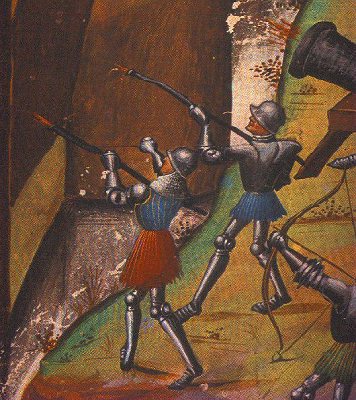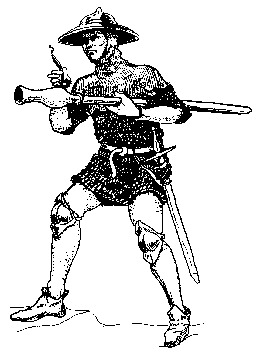Gunpowder Weapons of the Late Fifteenth Century

|
|
Gunpowder weapons were the 'leading edge' of technology in the late medieval era. Gunpowder
weapons took two forms: artillery, and hand-held guns. The two systems were
employed tactically in sieges and battles, and in offense and defense operations. All forms of
gunpowder weapons relied on chemical and metal-working advancements of the time, and their
effective exploitation in warfare relied upon new thinking of the military commanders.
For some time, there appears not to have been a distinction between artillery pieces, operated by
a crew, and smaller weapons capable of being operated by an individual. Even though there have
been a few examples of images and even hand-held weapons found from the earliest times, the
emphasis was on developing the cannon to blast holes in walls or to shatter fortress gates by what
would be considered an 'artillery' role, and complementary to what non-gunpowder siege engines
had been doing for centuries. Handguns were complementary to other missile weapons, mainly
the crossbow. Initially, the awkwardness in firing handguns limited their use as a 'marksman's'
missile weapon, but they had a role, when employed in numbers, to deliver suppressive and
harassment fire.
The earliest employment of gunpowder weapons may not have been recorded, as such incidents
in battle were most likely experiments. The first few reports of guns in chronicles are often
questioned. Modern scholars distinguish between combustible objects being hurled from
non-gunpowder machines, and the actual use of gunpowder as an explosive to propel objects
from a gun. Many of the early accounts lack sufficient precision to make a reliable
determination if a 'true' gunpowder weapon were being described. The earliest reliable reports of
guns suggest that their use had been ongoing. Initially guns were most used in sieges, in which
they did not become decisive until the late part of the Hundred Years' War. Early gunpowder
weapons were awkward in open battles. They were first effectively used during the battles of The
Hussite Wars (1419-34). Though they were present on many battlefields, beginning in the late
fourteenth century, guns' first effective employment [distinctly contributing to the conduct of the
battle] in the Hundred Years' War was at Formigny (1450). At Castillon (1453) guns were a
major factor in deciding the outcome of the battle.
The use of gunpowder weapons in the Hundred Years' War did not produce a revolution in
tactics, but it did spur the technological development and logistical support systems for such. In
the war, guns were used along with the older non-gunpowder weapons. The introduction of
gunpowder weapons was an evolutionary process that required progress in technology and in
understanding of commanders (the best of whom were not the traditional knight, or noble
men-at-arms, who were the main subjects of the contemporary chronicles).
|
|
|
|
Events Relating to Use of Early Gunpowder Weapons
in Western Europe
|
|
Mention and knowledge of gunpowder:
- c.1044
- The essential ingredients of 'gunpowder' were recorded in a
formula in China. Its explosive qualities had obviously been known for
some time in the Sung Dynasty. Its use in Chinese firework
demonstrations is certain. Though it is evident that the Chinese, and
later the Arab civilizations, experimented with a wide-range of
mixtures, there is some doubt if either society used the mixture as a
propellant of projectiles.
- c.1268
- The thirteenth-century transmission of the gunpowder formula to Western Europe has not been documented.
- Roger Bacon's Opus tretium provided a recipe with the
components of
gunpowder and suggested awareness of the mixture's explosive power. He
had made a cryptic reference to the mixture in an earlier document, Epistolae de secretis operibus, in 1249.
- c.1270-80
- Albertus Magnus (d.1280) left a manuscript (dated c.1270) that
included the work attributed to a 'Marcus Graecus' of an earlier time.
The Graecus' work was titled Liber Igneum ad comburendos hostes [Book of Fires for Burning enemies] and contained workable recipes for explosive gunpowder.
Reports, records, or evidence of guns:
- 1284
- Records of Italian use of sclopi (handguns) at town of Forli is suspected to be a later insertion.
- 1313
- Records reported that bussen met kruyt ('cannons with powder'?), were kept at the
town of Ghent. Interpretation is questioned by some English authors.
- 1324
- Guns were reportedly used at a siege of Metz. The report is questioned due to the
chroniclers' use of the term 'serpentines', believed to be a premature convention.
- Nasrid Sultan, Ismail I, of Granada reportedly used gunpowder artillery to capture
Huéscar in Spain. Reports of early Spanish Muslims' use of guns are questioned by some
who claim the accounts are of incendiaries being launched by non-gunpowder machines and not
of projectiles being propelled through a barrel by a gunpowder explosion.
- 1326
- Council of Florence directed the manufacture of metal cannon and bullets (pilas seu
pallectas ferreas et canones de metallo). Considered by many to be the first 'indisputable'
record of such items.
- The image of a pot-de-fer gun, that shot an arrow-like bolt, was in a manuscript (by
Walter de Milemete) presented to Edward III on his accession to the throne of England.
- 1327
- English reportedly used guns ('crakys') in Scotland.
- 1331
- Guns, vasi e scioppi, were used at siege of Cividale, in Friuli, Italy.
- 1338
- French document described acquiring iron arrows and sulfur, with which to make powder to
shoot the arrows.
- French used pot-de-fer, firing bolts with iron feathers, in a naval raid against
Southampton.
- 1339
- French used cannon [pot-de-fer] at Perigord; and at Cambrai against Edward III.
- 1340
- French used pot-de-fer at Quesnoy in 1340.
Italian painting of this date shows handguns.
- 1341
- At Lucca, there was reported use of a 'thunderer', and of iron cannon firing iron balls.
- 1342
- Spanish Muslims used cannon against Casilian army at Siege of Algeciras.
- 1343
- Spanish muslims used gunpowder against Alfonso XI of Castile.
- 1345
- French had 24 cannon made at Cahors for the siege of Aiguillon.
- Edward III had a hundred cannons at the Tower of London.
- 1346
- Some accounts state that cannon was used at the battle of
Crécy. Though the account is stated without qualification in many
modern writings, it is disputed by several historians.
- Edward III reportedly used 22 cannon his campaign in France.
- 1370
- Reference to gun foundry at Augsburg.
- 1375
- French employed 32 cannon and fired 100 pound stone balls during siege at
Saint-Sauveur-le-Vicomte.
- 1376
- Reference to gun foundry at Venice.
- 1378
- First mention of cannon used in Balkan lands relates to 13
August 1378 defense of Kotor firing three bombards at Venetian
warships.
- 1382
- A militia from Ghent, in a defensive position approximately an
hour's march from the city of Bruges, employed small cannon in routing
the Bruges' militia that marched out to engage them. The 3 May
encounter is called 'the battle of Beverhoudsveld'.
- 1386
- Reportedly Swiss used some handguns at Battle of Sempach.
- 1389
- Ottoman Turks reportedly used canon at 'First' Battle of Kossovo.
- 1399
- Richard II of England reportedly took eight 'gunnes' with stands and 200 rounds of shot to Ireland.
- 1400
- Konrad Kyeser's Bellifortis (c.1400) contained an illustration of a gunner firing a
small, culverin-like gun supported by an upright pole and a long shaft extending from its breech.
The gun is being positioned by the gunner's one hand as his other hand is aligning a hot rod to the
gun's touchhole.
- 1411
- First known image of a Z-shapped trigger-lever 'matchlock' gun is in a manuscript of this date.
- 1419
- Initial battle, near Prague, of the 'Hussite Wars' began a
series of engagements (lasting until 1434) which evidenced a definite
tactical scheme for the employment of guns (small artillery pieces and
handguns). The Hussites' employment provided undeniable effectiveness
of guns in combat when (as with the English longbow) a missile weapon
was used, supported by combined arms (other disciplined infantry and
cavalry) and in an offensive-defensive tactical posture.
- 1429
- At the English siege of Orléans, the French gunner Jean de
Montesiler demonstrated remarkable marksmanship in targeting individual
enemy targets. The accounts suggest that his individual firearm may
have been a matchlock equipped couleuvrin.
- 1435
- Handguns (culverins ad manum), supported on stands, were reported used at Rouen.
- 1442
- French established artillery parks: at Dax in 1442, at Mauléon in 1449, and at Guissen in 1449.
- 1448
- At the second Battle of Kossovo (17 Oct 1448), the Hungarians
under Hunyadi reportedly employed German and Bohemian mercenary
handgunners against the Turkish Janissary archers. The infantry
on both sides used palisades while exchanging missile fire at an
interim distance of about 91 meters. Though the far more numerous Turks
won the battle, Sultan Murad II (1421-1451) was sufficiently impressed
by the encounter to incorporate soon after handgunners in his
Janissary.
- 1449
- Mons Meg, a famous 'giant' iron bombard was made
for Philip the Good, duke of Burgundy. This followed the trend set by
the acquisition of another giant, Dulle Griet, a few years earlier.
- The French artillery under the direction of Bureau brothers
demonstrated striking success in sieges without use of the 'giant'
bombards. The French emphasis was on a large number of regular and
smaller guns [particularly longer barrel length-to-bore size ratios],
and a highly organized supply and support base. There is the
possibility that they were making use of the newly developed and more
powerful 'corned' gunpowder.
- 1450
- French employed two culverin-type guns that forced English
longbowmen to break their
traditional, defensive battle formation at the battle of Formigny. The
issue was not decided by guns, which the English managed to capture,
but by the French heavy cavalry that attacked the English exposed from
their defenses.
- 1453
- French employed about 300 guns (artillery and handguns) at the
battle of Castillon. This
engagement was a close replica of Hussites' tactical use of guns,
without the wagons, but
skillfully adapting to favorable defensive terrain. The guns had
largely decided the outcome by the time the French cavalry charged in.
- Constantinople fell to Sultan Mohammed II, who had employed a
large number of 'giant', mostly cast-bronze, bombards in his siege of
the city. However, the large guns' contribution to the victory is often
exaggerated.
- 1454
- Cannon reported to be mounted on two-wheeled gun-carriages at Rouen.
- 1470-80
- Believed actual timeframe of the 'Hussite Manuscript', whch
explains the relatively advanced [for time era of the Hussite wars
(1419-34)] images of gun-carriages in the document.
- 1474-77
- The Burgundian-Swiss wars evidenced that the Charles 'the
Rash', duke of Burgundy's, fascination with and promotion of artillery
was not matched with a skill for its employment in combat.
- 1483
- Berner Chronicles contains creditable images of two-wheeled gun-carriages.
- 1481-92
- Ferdinand and Isabella exhibit a strong artillery arm in their
conquest of Granada. Although the technological status of the
Castilian-Aragonise artillery did not seem to have advanced much beyond
that of the Hundred Years' War, their infantry evidenced a significant
increase in use of matchlock handguns -- the espingardas.
- 1494
- Charles VIII's French army invaded Italy with a highly developed artillery train and guns mounted on carriages with trunions.
|
|
|
| RETURN |  | To DIRECTORY |
|
|
|
|
Artillery may be roughly placed in two general categories according to
tactical employment: indirect fire (throwing or lobbing) objects (projectiles) toward a target area,
and directly shooting a missile at a target. Contrary to the impression given in many general
histories, medium-size guns were the most effective for bombardment. Guns of great size
induced a degree of psychological fear, but often failed during intense use.
|
|
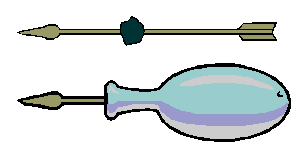
|
Earliest gunpowder artillery shot metal arrows (bolts) [grands carreaux] from iron or cast bronze, vase-shaped 'guns', or pots de fer. Italian espression was 'vasi'.
It is suspected that a tampion, or some sort of wadding, was wrapped
around the shaft of the projectile to enhance the thrusting eneregy of
gases released by the explosion of the gunpowder.
|
First image of these vase-configured guns was in the
Milemete Manuscript of 1326 presented to Edward III of England. Some
accounts suggest that such guns were the 'crakys of war' used in Edward
III's 1327 campaign in Scotland. It is also speculated that these were
the French 'bombards' used at Quesnoy in 1340.
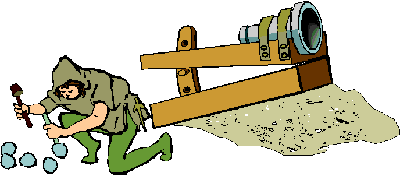
| Early bombards, that shot
stone-hewed projectles were fastened to wood platforms or trestles and
positioned on earth mounds. Simple devices were used to make slight
adjustments in elevation. |
Initially the guns were shaped like buckets, wide at the open mouth and
narrowed at the rear (where the gunpowder was packed) and a small hole
(touchhole) was located for the insertion of a hot wire, or lit coal,
to ignite the gunpowder. These very early bombards
would in the following century be called 'mortars' to distinguish them
from the longer barreled guns that are more typical of the major
bombards of the fifteenth century.
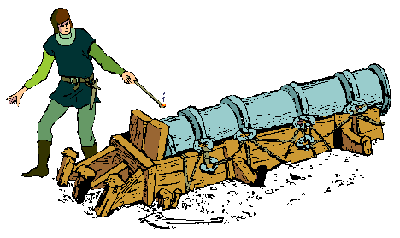
|
|
Bombard was a term that could be a generic, early medieval
artillery piece. However, as time passed, the term was applied to the
larger cannon. As specific sizes were not standard, one could say that
guns which shot projectiles larger than a human's head were generally
'bombards'.
The larger bore diameter guns usually shot stone balls and were
muzzle-loaded. Some bombards were large at the mouth end, but narrowed
to the rear (breech), where they might have had removable fire chambers
-- making them 'breech loaders'. Excluding the few very large guns
(which were usually given individual names), the following data would
generally apply for the average bombards:
Crew: about a 10 to 20
Rate of fire: 2 per hour (muzzle loaded)
Projectile: up to 100 kg (about max for the average gun)
Range: 220 meters (very rough average estimate)
|
Example of a siege bombard ca. 1450
|
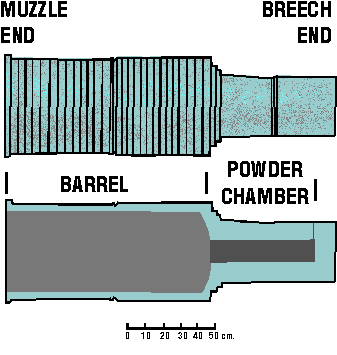
|
This is a cutaway of one of the ca. 1450 bombards kept at the Musée de l'Armée, Paris, France.
This is a rather typical configuration of bombards of the fifteenth
century. They consisted of two distinct tube-like sections: a long barrel sections and short powder-chamber sections. The barrel had considerably large bore caliber size compared to that of the powder chamber.
Most of the bombards of the early fifteenth century were
hamered-forged, wrought-iron pieces. Their powder chambers and barrel
sections were made separately, and then the chambers were rigidly
attached to the barrel. Some authors have mistakenly assumed that these
were screwed together after a practice of manufacture in the very late
fifteenth-century with cast-bronze guns. As many of the remaining iron
bombards are too corroded to asses the difference without x-ray
examination, this distinction has only been recently confirmed. The
deteroiated condition if the guns also conceals the forged manufacture
of many of the chambers, which otherwise have been mistakenly assumed
to have been cast.
Cast bronze guns were known to be safer from explosion, and as
gunpowder imporved in explosive power in the latter part of the
fifteenth century, more bronze guns were made, though they were more
expensive. Not many of the bronze bombards remain as they were melted
down in later eras for more modern artillery, church bells, etc.
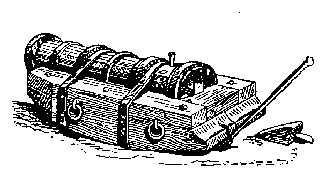
|
| Smaller bombards, mounted
on wooden sleds, provided a degree of tactical mobility before the
development of suitable two-wheeled gun-carriages late in the fifteenth
century.
|
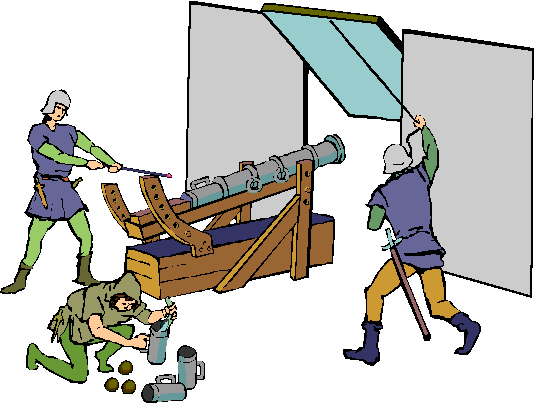
|
|
Culverin and veuglaire were cannon of narrower diameter
and considerably greater ratio of barrel-length to bore-diameter than
that for bombards. They shot projectiles about the size of a human
fist. The culverins and veuglaire type guns proved to be versatile and
effective guns in the late medieval period. It became economical to use
cast iron shot with them, which enhanced the guns' effectivness.
|
Cannon of this design were most all breech-loaded.
Beer-mug shaped chambers were pre-loaded with powder charges and then
wedged tightly into the open rear of the piece. This allowed for a more
rapid rate of fire than for the muzzle-loading guns. This factor, along
with their more managable size, caused culverins and veuglaires to be
the first types of gunpowder pieces to be used in open-field battles.
To be effective, guns had to be
place close to walls. Gun crews had to be protected from the enemy
counter missile fire (guns and arrows) and large shields were erected
at the gun sites.
Removable firing chambers, in which powder was
loaded, allowed for safer and more rapid firing rates. This system was
more prictical on the smaller bore guns and not adopted for most
bombards. There is some question whether the shot was placed in the
removable chambers along with the powder and wadding, or was the shot
placed at the breech end of the barrel and the removable chamber loaded
merely with powder and wadding.
Culverin/veuglaire type cannons were given many
other names that had particular meanings to the chroniclers and
operators at the time. There is no record of a systematic labeling of
guns until the sixteenth century. However, the French artillery under
the Bureau brothers attempted to 'standardize' the diameters of the
guns to a few specific sizes, as part of their logistical measures in
managing the large artillery inventories of Charles VII, and later of
Louis XI. Eventually, the 'culverin' became associated with the very
narrow diameter [small caliber] guns and with the smaller hand-held
weapons.
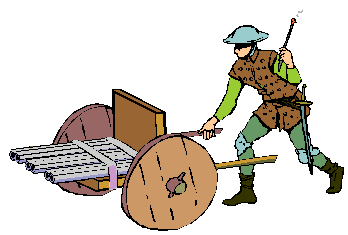
|
ribauldequin, or 'rabaud', or 'organ guns', were in use during
the first part of the fifteenth century, and continued as a mostly
anti-personal gun.
|
|
|
| RETURN |  | To DIRECTORY |
|
|
|
|
|
Handguns had developed considerably by the late
fifteenth century. They began by mounting very small, culverin-like
cannon on long staves (or stocks). These small guns were usually called
'cannon or culverin à main'. The
gunner was called a coulevrinier.
The earliest handguns had to be supported and were fired by a hand-held
lit match being brought to the touchhole. Sometimes this was done by an
assistant.

|
Earliest illustration of a 'handgun' from Konrad Kyeser's Bellifortis (c.1400).
|
During the early fifteenth century the pole became
shorter and took the form of a stock that rested on the gunner's
shoulder, or under his arm. About mid century, the invention of the
matchlock firing system allowed the hand-held weapon to be completely
operated by one individual. Around the second quarter of the century,
improvements in gunpowder made small guns firing lead bullets more
effective. However, in the course of the Hundred Years' War no tactical
innovations emerged that were unique to the weapon. Handguns were
employed much like crossbows, which they were beginning slowly to
replace.
|
|
|
|
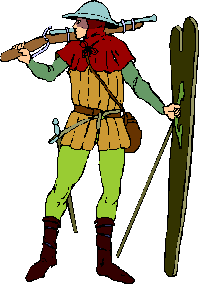
|
Hand-gunner (or arqubusier) shown here with the
arquebus, which appeared just about at the end of the
Hundred Years War. [Some evidence suggests its earliest forms were
available in the Hussite armies of 1419-34.] It was
distinctive for the primitive matchlock system, where the lit match was held by one end of a large
'serpentine' [S- or Z-shaped] bar which, when the gunner moved the other end (like a trigger lever), aligned the lit
match to the touchhole. The device allowed the small gun to be a true individual's missile weapon.
The employment of handgunners resembled that of crossbowmen. They used the large shield
(mantelet or pavise)
when firing from a non-protective cover position. The low rate-of-fire
meant that they had to be employed in large numbers to be effective in
infantry tactical situtations. However, handguns were cheaper to
produce than crossbows and took less training to operate.
Handguns were not the weapon of nobleman and the gunners
are generally ignored in the medieval chronicles. However, the
extensive documented material spawned by Jeanne d'Arc's dramatic
episode provides a noteworthy description of one remarkable marksman.
For a discussion of what might have been his weapons, see the webpage on Maitre Jehan de Montesiler.
|
|
|
| RETURN |  | To DIRECTORY |
|
| RETURN |  | To Top of Page. |
|
|
|
|

|
Return to Hundred Years' War Web Page.
|

|
Return to Oriflamme Web Page.
|
|
This page was last updated 16 May 2001. Comments can be sent
to the Société de
l'Oriflamme.
|
|









